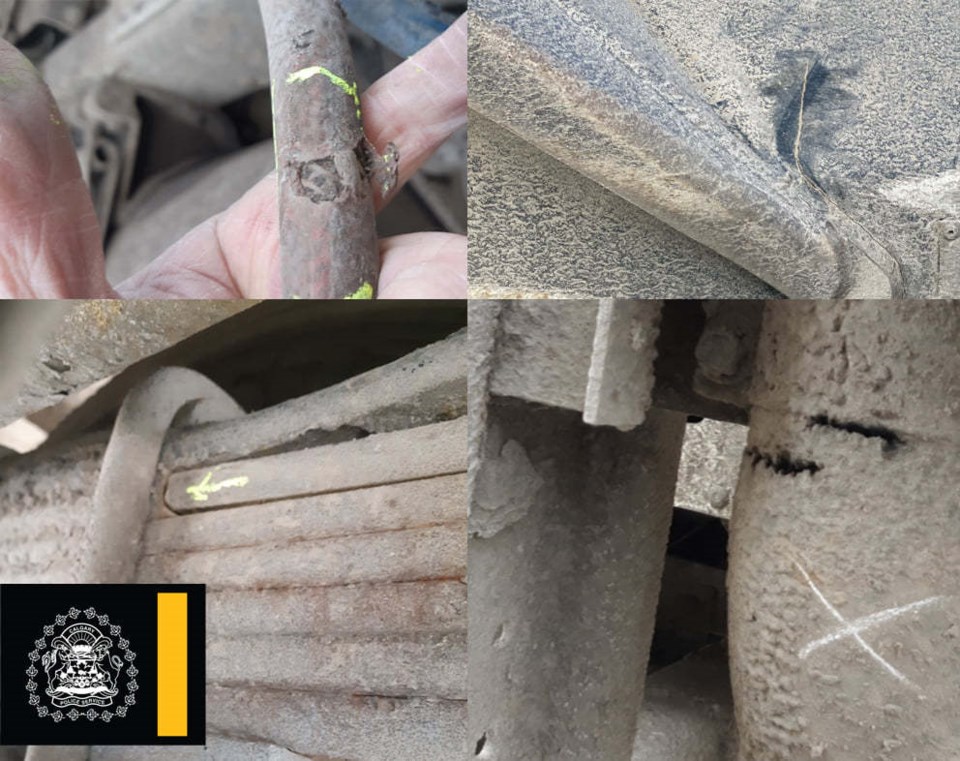Twenty-three commercial vehicle operators were issued safety violation tickets south of Airdrie on Jan. 26, during a joint-forces inspection operation conducted by the Calgary Police Service (CPS) and the Alberta Sheriffs Highway Patrol’s Airdrie Vehicle Inspection Station.
Stationed around Balzac that day, CPS and Alberta Sheriffs Highway Patrol officers assessed 26 commercial vehicles along Cross Iron Drive, Dwight McLellan Trail, and Highway 566. According to a social media post from CPS, only one vehicle passed the safety inspection, and 23 violation tickets were handed out to drivers.
While those statistics can seem alarming, CPS officer Sgt. Colin Foster said the reason for the high rate of infractions is that the inspectors were specifically targeting commercial vehicles they felt would fail the inspections. He said the results of the Balzac inspections on Jan. 26 were “pretty much par for the course” for the CPS' weekly outings.
“If I see a commercial vehicle coming down the road and think that vehicle will fail the inspection, I’ll pull it in to see if it will fail the inspection and deal with any defects that may be on the vehicle that could cause a collision further down the road,” he said.
In their social media post, CPS stated infractions on Jan. 26 included broken suspension springs, loose u-bolts, a cracked drawbar, brakes being out of adjustment on a large tow company’s vehicle, worn air lines, and multiple loose steering pitman arms.
What happens after a commercial vehicle driver fails an inspection depends on the severity of the defect, according to Foster. He said if a defect is considered particularly dangerous, the vehicle will receive an out-of-service designation, which means the defect must be repaired before the vehicle can continue down the road.
“That could mean they bring a mechanic out to do the repair, or a low-loader has to come along so the vehicle can be [towed] to a mechanic shop,” he said.
For vehicles with less serious safety violations, Foster said the driver can continue to operate the vehicle for the remainder of their trip, but once arriving at their next destination, the vehicle is not allowed to be driven again until the defect is repaired.
In terms of prosecutions, he said it’s up to the officer conducting the inspection to determine whether or not to issue any violations.
Foster said the CPS' weekly safety inspections are specifically for commercial vehicles, adding those automobiles tend to have a gross weight of at least 4,500 kilograms without any cargo.
“We’re looking at delivery trucks, semi trailers – that kind of thing,” he said.
According to Foster, the main benefit of police conducting regular commercial vehicle safety inspections is the possibility of discovering vehicles that have critical safety issues early, and getting those off the road before they lead to an avoidable motor vehicle collision.
“We’re talking about things like steering components that are worn or loose, or I found one that had a broken main spring on the suspension system,” he said. “We find vehicles that have insecure cargo, brakes out of adjustment...We’re not talking about minor defects – we’re talking about fairly serious defects on these vehicles that if they continue down the road and aren’t addressed could lead to a major collision that we don’t want to see occur.”
He added that similarly to ticketing speeders, having police officers conduct commercial vehicle safety inspections is a method of keeping roads safe.
“We want to let the public know we are dealing with the commercial vehicle industry,” he said. “It’s not that we’re picking on them or anything like that. What we want to do is highlight that CPS is dealing with commercial vehicles, we are making the roads safer, and we’re working with industry to make sure commercial vehicle road users are safe.”



